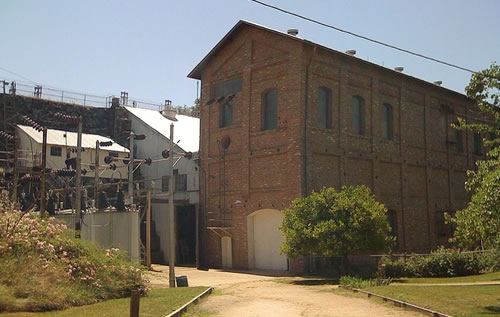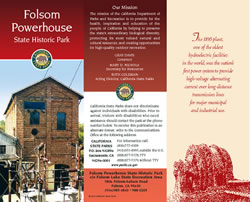Horatio P. and Charles Livermore
During California State Fair Week in 1879, a flash of the future entranced Sacramento residents. The Sacramento Union and Weinstock, Lubin and Company Department Store sponsored a public exhibit of electric lighting. Nearly 5000 visitors viewed a display of sizzling and dangerous arc lights. The resultant desirability of electric power in the state capital became paramount, but a solution was difficult to envision in the 1880s. Electricity was expensive to generate since it utilized batteries or coal-powered steam engines that transmitted only limited power over a short range. Devices that required little electricity such as telegraphs, telephones or burglar alarms were the few items that used the power source.
Electricity a Wave of the Future
But electric power was clearly the wave of the future and a cheaper, more efficient form of long-range electrical transmission was sought. After the incandescent light bulb was introduced to Sacramento in 1890, the call for electric availability increased dramatically. The State Capitol Building installed outlets for 1400 electric lights. Despite the exorbitant cost of coal to run steam dynamos, Southern Pacific Railroad shops converted to electricity. Regardless of the mounting popularity of electric power, the problem of discovering a mechanism to produce inexpensive and abundant energy remained. A few hydraulic mines in the Sierra foothills had experimented with hydroelectric power (electric power created by water turbines) as early as the 1880s. Perhaps that was a solution.
Starting in the 1860s, the Natoma Water and Mining Company, a firm near Folsom, had built an extensive network of dams, ditches, and reservoirs to supply water to mines on the American River in the Gold Rush period. The owner, Horatio Gates Livermore, wished to build a dam on the river for a sawmill holding pond. The project was enormously costly and required significant quarrying and construction. California even agreed to supply prisoners from nearby Folsom Prison as a labor force.
The work proceeded slowly, and by the 1880s, Livermore had died, and the company was controlled by Livermore’s two sons, Horatio P. and Charles Livermore. The sons revised the project and embraced the possibility of hydroelectric power generation on the worksite. While a handful of hydroelectric plants had been constructed in Germany and New York, they were small scale experiments. The Livermore Brothers had bigger plans. They would dig a 9,500-foot canal that would provide water power to four of the largest electrical generators, or dynamos, ever constructed.
In 1895, the Journal of Electricity exclaimed, "these are without doubt the largest three-phase dynamos yet constructed." Each dynamo was more than eight feet tall, weighed in excess of 57,000 pounds, featured 1260-horsepower dual turbines, and could produce 750 kilowatts. They were driven by eight-foot diameter penstocks using water from the American River delivered through the canal. Construction on the hydroelectric facility began in 1894. 
Transmitting Electricity Long Distance
By 1895, the elegant brick Folsom Powerhouse was completed and ready to transmit electricity to Sacramento, twenty-two miles away, a distance far greater than electricity had ever been distributed. The Livermore Brothers, and their new partner Albert Gallatin, President of the Huntington-Hopkins Hardware Company of Sacramento, anticipated great success and vast profits. Not surprisingly, since the trio had incorporated the monopolistic Sacramento Electric Power and Light Company, and had received a Capitol City franchise to construct an electric streetcar system.
The partners decided to announce the arrival of electric power in Sacramento with a theatrical flourish. At 4 AM on July 13, 1895, a 100-gun salute awakened the slumbering residents of Sacramento with a dramatically explosive declaration that electricity had been conveyed (over uninsulated copper wire) from Folsom to Sacramento. It was the first time that high-voltage alternating current had been successfully conducted over a long distance, a groundbreaking scientific and engineering accomplishment. The Sacramento Bee exclaimed: "Not only is this the longest power transmission in the world, but it is also the largest electric power plant in the world, in the sense of the power actually developed…with a capacity of 4,000 horse power actually delivered for use in this city."
A Grand Electrical Carnival
On September 9, 1895, California observed Admission Day, a state holiday marking California’s entrance into the Union in 1850. In Sacramento on that day, they also celebrated the arrival of cheap electric power by staging the elaborate "Grand Electrical Carnival," stringing lights along downtown thoroughfares and decorating the State Capitol Building with thousands of incandescent bulbs. The next day, the Sacramento Bee reported that over 60,000 people had witnessed the spectacular display:
Sacramento’s pulse beat high and fast last night. She had cast aside the old and faded robes of her humble childhood days and stood at the new altar of celestial fire to be made the bride of Progress of the new century that is about to dawn…. Twenty-five thousand incandescent lamps, in the cherry red, apple green and orange tints of the carnival made the streets and upper air ablaze with light…. They outlined the cornices, the roof, and every column, balcony and rib of the great dome of the Capitol building up to the bird cage at the top.
 Using the same basic equipment, the Folsom Powerhouse continued in operation until 1952, until it was replaced by the hydroelectric plant at the recently completed Folsom Dam. In 1958, the powerhouse complex was acquired by the California Department of Parks and Recreation. The Folsom Powerhouse has been designated a National Historic Civil Engineering Landmark (1975); a National Historic Mechanical Engineering Landmark (1976), and was chosen as California Historical Landmark #633. In 1981, the Powerhouse was listed on the National Register of Historic Places.
Using the same basic equipment, the Folsom Powerhouse continued in operation until 1952, until it was replaced by the hydroelectric plant at the recently completed Folsom Dam. In 1958, the powerhouse complex was acquired by the California Department of Parks and Recreation. The Folsom Powerhouse has been designated a National Historic Civil Engineering Landmark (1975); a National Historic Mechanical Engineering Landmark (1976), and was chosen as California Historical Landmark #633. In 1981, the Powerhouse was listed on the National Register of Historic Places.
Image Credits:
- The Folsom Powerhouse Source: Collections of the California State Parks
- The Folsom Powerhouse State Historic Park Source: Collections of the California State Parks
